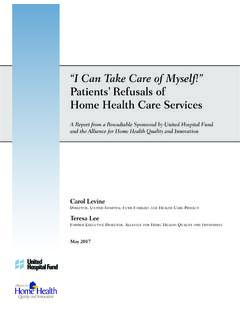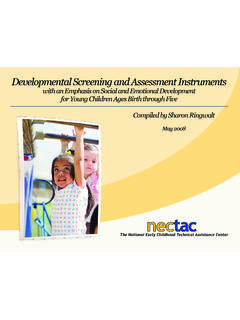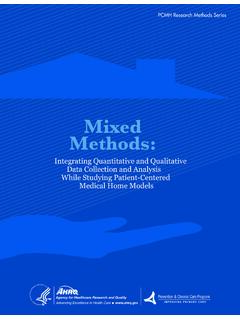Transcription of AHHQI Care Transitions Tools Kit r010814
1 Improving Care Transitions Between Hospital and Home Health: A Home Health Model of Care Transitions January 2014 For more information about this model or the additional work of the Alliance for Home Health Quality and Innovation, please visit Home Health Care Transitions Tool Kit | Page 2 of 71 Document Instructions: These documents are hyperlinked. Please click on any link in the Table of Contents (below) to be taken to that document. Please click the top of any page to return to the Table of Contents. Table of Contents!Purpose and Instructions .. 4 Background and Overview: A Home Health Model of Care Transitions .. 5 Transitional Care Checklists .. 9 In-Hospital Transitional Care Checklist .. 10 Home Health Start of Care (First Visit) Checklist.
2 11 Home Health Second Visit Checklist .. 12 Subsequent Visits Per Plan of Care Checklist .. 13 Key Elements for Care Transitions Tools : Core Components Lists .. 14 Core Components: Personal Health Record (PHR) .. 15 Core Components: Medication List .. 16 Core Components: Red Flags Symptoms Exacerbation Tools .. 17 Transitional Care Guidance .. 18 Advance Directives Guidance .. 19 Universal Health Literacy Guidelines .. 20 FAQs: Federal Requirements and Guidance on Interpretation and Translation for Limited English Proficient (LEP) Individuals .. 22 Evidence-Based Care Transitions Tools (DO NOT MODIFY) .. 24 Risk Assessment: In-Hospital Assessment OASIS-C1 Question M1033 .. 25 Risk Assessment: In-Hospital IHI Risk Stratification Tool .. 26 Health Literacy Assessment: REALM SF Tool.
3 27 Health Literacy Assessment: REALM R Tool .. 28 Health Literacy Assessment: The Newest Vital Sign Test and Scorecard .. 34 Health Literacy Assessment: Single Item Literacy Screener .. 36 Patient s Personal Health Assessment: EQ5D Tool .. 37 Patient s Personal Health Assessment: HHCAHPS Tool .. 41 Home Health-Physician Communication: Admission to Home Care Summary for PCP Tool .. 42 Red Flags Symptom Exacerbation: COPD Tool .. 43 Red Flags Symptom Exacerbation: Depression Tool .. 45 Red Flags Symptom Exacerbation: Falls Prevention Tool .. 47 Red Flags Symptom Exacerbation: Heart Failure Tool .. 49 Red Flags Symptom Exacerbation: Pneumonia Tool .. 51 Sample Tool - Personal Health Record (PHR) .. 53 My Personal Health Record .. 53 My Personal Health Goals .. 54 About Your Personal Health Record.
4 55 My Personal Information .. 56 About My Health .. 57 Home Health Care Transitions Tool Kit | Page 3 of 71 My Health Care Team .. 58 My Health Wishes (Advance Directives) .. 60 My Past Surgeries and Hospital Stays .. 62 Vital Signs .. 63 My Physician Visits .. 64 How to Give Your Doctor a Quick, Clear Picture of Your Health Problem Over the Phone .. 65 Questions for My Health Care Team .. 66 Talking with Your Healthcare Provider at the Appointment .. 68 My Medication List .. 69 My Notes .. 70 Technical Advisory Panel Members .. 71 AHHQI Home Health Model of Care Transitions | Page 4 of 71 Purpose and Instructions Developed by the Alliance for Home Health Quality and Innovation, this document sets forth a home health model for care Transitions from hospital to home health.
5 This model and its accompanying Tools are meant to cover the care transition from admission to the acute care inpatient hospital to home health care. In light of the growing emphasis on using appropriate care Transitions and post-acute care to reduce unnecessary hospital readmissions, the development of this model and accompanying Tools has been an initiative to support the home health community s efforts to improve quality of care. The model and Tools were developed through an Alliance-convened technical advisory panel comprised of clinical experts and leaders in home health organizations. These are clinical leaders who specifically have expertise on providing health care in the home setting. The technical advisory panel members identified the practices and Tools set forth in this model of care after reviewing the existing literature .
6 Thus, based on their expertise and a review of existing literature , the model and accompanying Tools represent what key clinical experts in home health believe are best practices for hospital to home health care Transitions that should facilitate improvements in quality of care. The model and Tools are intended for use by both home health providers and their hospital partners in caring for patients in the context of preparing for, and providing, post-acute care. The Alliance plans to make the model and Tools available for public use. Please use these Tools as they apply to your setting and needs. In the future, the Alliance intends to make the model and Tools the basis of testing and evaluating home health s impact on patient care outcomes. As evidence is developed over time, the model and Tools will be revised as needed.
7 Finally, the model and Tools emphasize care for, and communication with, the patient, but we note that family members and caregivers play critical roles in caring for the patient. Family and caregiver engagement is often key to ensuring quality of care for the patient and such engagement should be considered implicit in the model elements and Tools . The Alliance wishes to thank the members of the technical advisory panel for their considerable contributions of time, energy and expertise, without which the model and Tools in this document would not exist. Feedback and questions on the model and Tools can be directed to the Alliance staff at (202) 239-3206. Sincerely, Teresa L. Lee Executive Director AHHQI Home Health Model of Care Transitions | Page 5 of 71 Background and Overview: A Home Health Model of Care Transitions I.
8 Improving Care Transitions Between Hospital and Home Health Today, health care providers and policymakers are focused on the goals of improving quality of care and reducing the overall cost of care. More specifically, many including the Centers for Medicare and Medicaid Services (CMS) are focusing on accomplishing the Triple Aim : Better care for individuals, as described by the six dimensions of health care performance listed in the Institute of Medicine s 2001 report Crossing the Quality Chasm (safety, effectiveness, patient-centeredness, timeliness, efficiency, and equity);1 Better health for populations, through attacking the upstream causes of so much of our ill health, such as poor nutrition, physical inactivity, and substance abuse; and Reducing per-capita costs.
9 In analyzing the opportunities to achieve these goals, many are looking to improve care Transitions , as these hand-offs present particularly important junctures of care for patients. One critical transition is from hospital to home and home health providers are often in the key position of helping patients to achieve a smooth and effective transition. Home health providers have teams of skilled health professionals who are ready and able to work closely with hospital staff, patients, and their families and caregivers to facilitate the transition from hospital to home. Although home health is well positioned to lead and facilitate care Transitions , home health is often not sufficiently recognized as being a critical partner in managing care Transitions . In part, this stems from the fact that leading edge models to date (such as the Naylor and Coleman models) do not explicitly include home health providers as a member of the care team carrying out transitional care interventions.
10 Many home health providers have appropriately adapted care Transitions models to the in-home setting in an effort to improve care Transitions and outcomes for their patients; but there has not been a comprehensive effort to identify the steps home health providers should take to improve the patient care experience and health outcomes during Transitions from hospital to home health care. 1 See AHHQI Home Health Model of Care Transitions | Page 6 of 71 II. Process: Defining a Model and Improving Competencies In light of the key role home health providers are playing every day in care Transitions , the Alliance s Quality and Innovation Work Group (QIWG) discussed the challenges discussed in Part I above and directed Alliance staff to pursue the possibility of a study to define and establish the effectiveness of a home health model for care Transitions .









